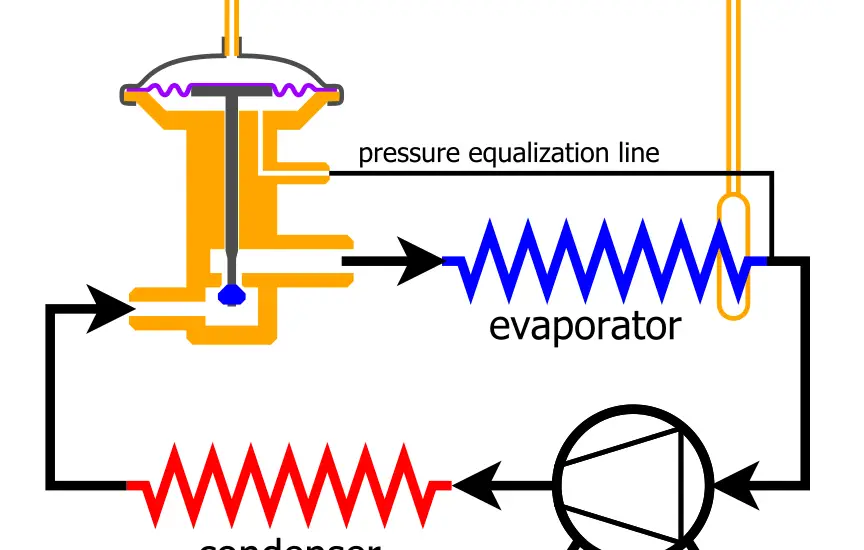This guide will walk you through everything you need to know about the expansion valve equalizer line.

Table of Contents
Understanding the Expansion Valve Equalizer Line
The expansion valve equalizer line is pivotal in cooling systems, particularly in thermostatic expansion valves (TEVs). Its main function is to balance pressures, making the TEV’s operation precise and effective. Below is a deeper explanation:
Pressure Equalization: By equalizing the pressure on both sides of the thermostatic expansion valve, it ensures that the valve opens and closes as intended. Without this balance, the valve may malfunction, leading to inadequate or excessive refrigerant flow into the evaporator.
System Efficiency: By maintaining the correct pressure balance, the expansion valve equalizer line allows the system to run at optimal levels, reducing energy consumption and wear on components.
Compatibility: It can adapt to different system configurations, including variations in evaporator load and compressor capacity, making it a versatile component.
Types of Equalizer Lines
Understanding the two main types of equalizer lines is key to selecting the right one for a specific cooling system.
Expansion Valve with External Equalizer
An expansion valve with an external equalizer is commonly used in systems where there’s a significant pressure drop across the evaporator. The external equalizer is connected to the suction line of the system. It has unique features and benefits:
Accuracy: External equalizers monitor the pressure at the evaporator outlet, which allows for a more accurate representation of the conditions inside the evaporator. This leads to precise control over the refrigerant flow.
Flexibility: They are suitable for various applications and can be adjusted to different system requirements, offering more versatility.
Maintenance: Having the equalizer line externally means that it can be accessed more easily for maintenance or replacement without having to interfere with the main valve.
This design enhances the system’s adaptability and performance, particularly in complex or large-scale cooling applications.
Expansion Valve with Internal Equalizer
The internal equalizer expansion valve has the equalizing function built into the valve. It is typically used in systems where the pressure drop across the evaporator is minimal. It is simpler but has some specific characteristics:
Simplicity: Since the equalizing function is contained within the valve, the installation is more straightforward, with fewer external components.
Cost: Generally, internal equalizers are less expensive due to fewer parts and easier installation.
Limitations: They are often best suited for systems without large pressure drops across the evaporator, as they may not be as precise in equalizing pressure in those situations. Systems with significant pressure differences might require an external equalizer for optimal performance.
Choosing Between Internal and External Equalizer
Selecting the correct equalizer is essential for system efficiency and longevity:
Evaluation of System Needs: Analyzing factors such as pressure drop across the evaporator, system complexity, and budget constraints will guide the choice.
Expert Consultation: Seeking professional advice can provide tailored recommendations based on specific system characteristics and requirements.
Long-term Considerations: Understanding how future changes or upgrades to the system might impact the choice of the equalizer is important for long-term performance and flexibility.
Check out these other related articles…
Expansion Valve Thermodynamics: A Comprehensive 411 Guide
Expansion Valve Working Principle: A Comprehensive Guide
Types of Expansion Valve in Refrigeration System: Easy Guide
Thermostatic Expansion Valve in a Refrigeration System: Easy 411 Guide
Thermostatic Expansion Valve Working Principle: Easy Guide
Installation and Maintenance
Correct installation and ongoing care are crucial to the functionality of the expansion valve equalizer line:
Installation: Proper placement and connection to the TEV and suction line (for external equalizers) are vital. Incorrect installation can lead to pressure imbalances and system malfunctions.
Maintenance: Regular inspections and servicing can prevent potential failures and ensure consistent performance. This includes checking for leaks, blockages, and wear.
Replacement: Being aware of the life expectancy of the equalizer line and planning for timely replacements can prevent unexpected system downtimes.